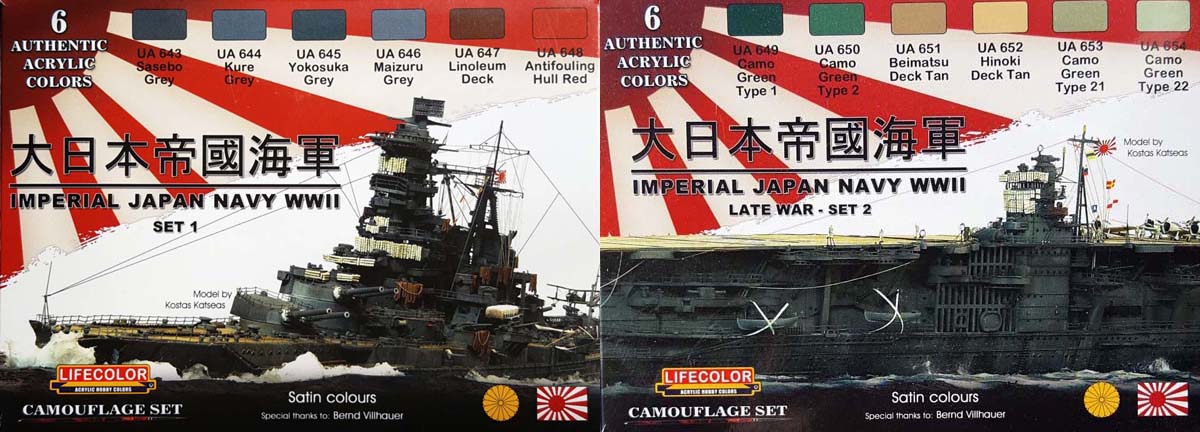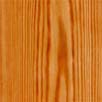
| Lifecolor Naval Paints Review– Imperial
Japanese Navy WWII
|
Reviewed December 2018
by Dan Kaplan
| This is a companion review to the Lifecolor paint review
of RN WWII colors by Devin Poore posted
a few months ago as part of the new reviews for September, 2018,
and the review for DKM WWII colors:
I was unfamiliar with this brand prior to the review. Lifecolor paints are an acrylic paint made in Italy. The paints come in 22ml plastic bottles. According to their website, the paints are water-soluble, nontoxic, nonflammable, and contain no alcohol, solvents, or lead. I can vouch that they have very little odor. From what I gather, they are well-regarded and popular paints, particularly among model railroad, armor and figure enthusiasts. The review samples included two sets of IJN colors:
|
|||||||||
| Cover Art | |||||||||
| Just for the reader’s information, the cover photo on set #1 is of a 1/350 Kongo 1944 (F) by Kostas Katseas, while his Akagi (scale unknown) graces the front of set #2. I think it fair to assume that he used Lifecolor paints for the models. | |||||||||
Imperial Japanese Navy Late War Set 1 (LC-CS36)
|
 |
||||||||
Imperial Japanese Navy Late War Set 2 (LC-CS37)
|
 |
||||||||
| Testing | |||||||||
| The testing was conducted on the same day, time, and location
as Devin’s tests with the RN & DKM paint samples. Atmospheric conditions
were warm and humid. The test was an absolute duplicate of what Devin did
with his review sets in that the samples were sprayed with a Grex airbrush,
shooting between 10psi and 30psi, onto a sheet of styrene primed with Badger’s
Stynylrez acrylic white primer.
Like the RN paints, they needed no thinning before airbrushing and sprayed evenly. Just a couple of passes were required to cover the white primer. Doing so resulted in a good, opaque application of paint. Drying times were on the slow side due to the day’s high humidity but they were dry to the touch within a half hour. The finish was a very nice and even matte surface. Adhesion to the primer was very satisfactory. In a subsequent test on a different day, I brush painted some test strips. I was initially disappointed with the results; the paint applied itself unevenly, in in a very thin and translucent manner. I will say that a second coat seemed to do the trick as far as achieving a proper level of paint opacity. The paint also was somewhat self-leveling, though I wouldn’t recommend just slopping it on. However, based strictly on my results, I would only brush paint in order to do small touch-ups. Clean-up was simple and straightforward, though we did not use any cleaner other than the Vallejo/Medea/Simple Green cleaners that Devin has on hand for acrylics. Later on, after my brush painting, I used warm water to clean the brush with no obvious problems. Admittedly, it was just a test brush and I was just looking for a basic yes or no on clean-up. Reportedly, distilled water works very well, leaving no residues. I’m unsure of what else might work well with them. |
|||||||||
| Color Matching | |||||||||
|
(Special Note: Devin made a great point in his review in that everyone’s device screen is not color calibrated the same way. So, what my Mk. 1 eyeball sees, and what’s represented here, and how they match up to the reference chips may not appear quite the same to the reader on their respective device.) Given time constraints that day, I focused primarily on the paints from set #1 and used the Snyder and Short IJN WWII color chips as my primary reference. Once sprayed, the four standard IJN Grays from Lifecolor all had tinges of green in them as compared to their respective S & S chips. I can’t say that any one of the Lifecolor greys was a better match to its corresponding S & S chip than the others, though each grey did show a tonal difference relative to its companion paints that matched the differences between the respective S&S grey color chips. In other words, the gradations between the different Lifecolor greys was very similar to those differences between their respective S&S reference chips, just with more green in them. The linoleum paint was a good match. While it was a little brighter in appearance than the reference chip, it has been documented that there were variations in the color of linoleum, particularly as affected by weathering. So, I think the Lifecolor version is more than acceptable.
There was enough time to also spray the Bei-matsu and Hinoki Deck Tans from set #2. Bei-matsu is, essentially, old growth American Pine that was used for IJN flight decks and possibly other deck coverings. It is a sort of golden tan with orange overtones. Bei-matsu Deck Tan does not have an equivalent S&S chip for reference, so I included two examples grabbed from an on-line site. There’s plenty of variability in samples, so one can Google old growth pine (also known as Longleaf Yellow Pine) for some good color references. This version maybe a little lighter and yellower than what I typically think of as Bei- matsu, but it’s certainly serviceable. A burnt umber wash over it would probably make it closer to the actual color (and that’s true for just about every deck tan paint out there). |
|||||||||
| The Hinoki Deck Tan sprayed a little more yellow-orange than its reference
chip. Hinoki wood is a very light-colored wood when new, almost a sand
color with yellow tinges. It turns to a greyish tone after considerable
weathering. The Lifecolor version did not really match the color of either
circumstance. On the other hand, it was warm enough to consider using
as alternative wood deck tan covering, just not for a specific Hinoki Cypress
covered deck.
Afterwards, I began to wonder if the acrylic white primer used as a background for the test sprays had altered how the Lifecolor greys are perceived by both the camera and the eye. If nothing else, that primer white seemed to have a slightly darker yellow, if not a little green, tinge to it as compared to the much starker white of the color reference chips. I couldn’t help but think that these paints, which spray a little thin, might not have taken on some of those background tones. Of course, this doesn’t account for how the RN & DKM samples that Devin tested remained truer to those reference chips. |
 |
||||||||
| So, I did retest the four greys on a starker white background, using a Sotar 20/20 airbrush at 20psi. This time, the applications were much heavier, as I used many more passes over the surface. Unfortunately, there was no appreciable change in the greenish tones. |  |
||||||||
| Closing thoughts | |
Surprisingly, the grays were all more tinged with green
than the reference swatches. I say surprisingly because the corresponding
box art for each grey has no green tinges, and that set up my expectations.
Also, the Lifecolor paints apparently have a very good reputation for color
matching. After further thought, I’d say that the Maizuru Navy Yard variant
seems to come closest to its corresponding reference chip when it comes
to evaluating the IJN greys.

Of the other colors tested, the linoleum matched best, the hull red worst, and the deck tans are more than acceptable as long as one is not looking for their use as Hinoki Deck Tan. While not perfectly keyed to the standard reference chips, these paints do have some appeal for me, particularly from their ease of use for airbrushing. The paints are prepared quite nicely for airbrushing right from the bottle. Conversely, the same quality and consistency that makes this possible works against their use for extensive brush painting. Touch-ups would be fine in my view. Clean-up was also exceptionally easy; making these paints a good alternative for modelers who prefer less demanding airbrush maintenance or work in confined spaces without good ventilation. I see these specific sets of paint as acceptable, with some reservations about color matching. Thanks to Airbrushes.com for the review samples. They carry the entire Life Color line of paints |
|
